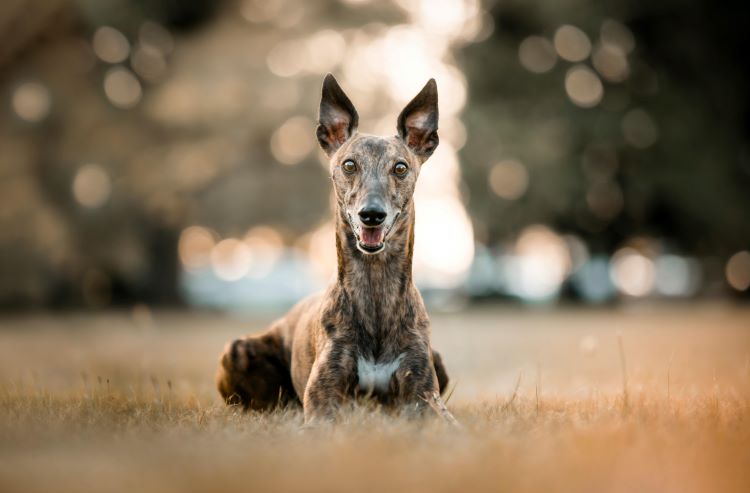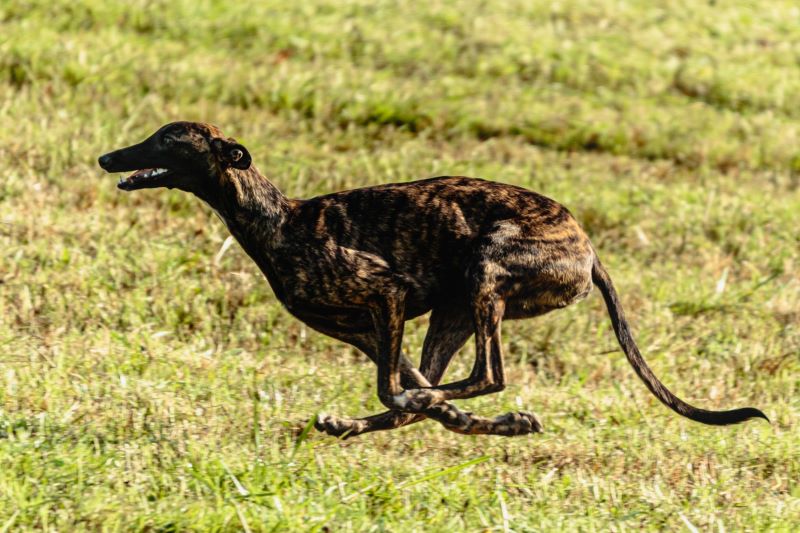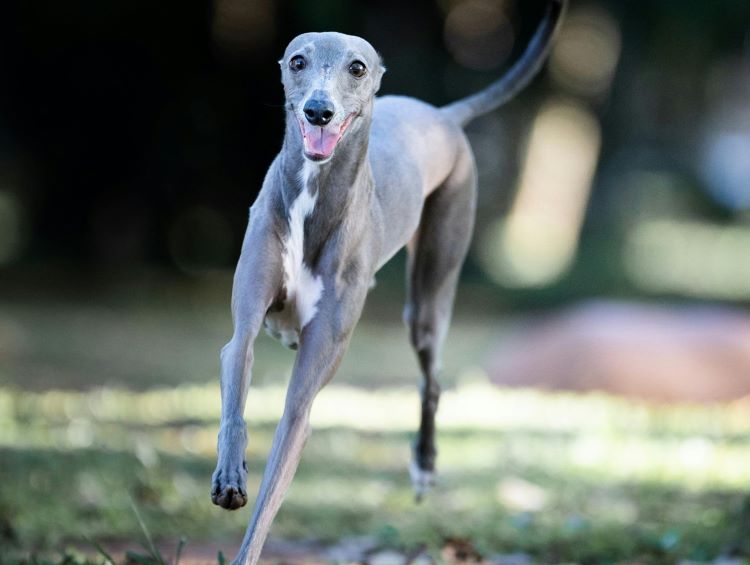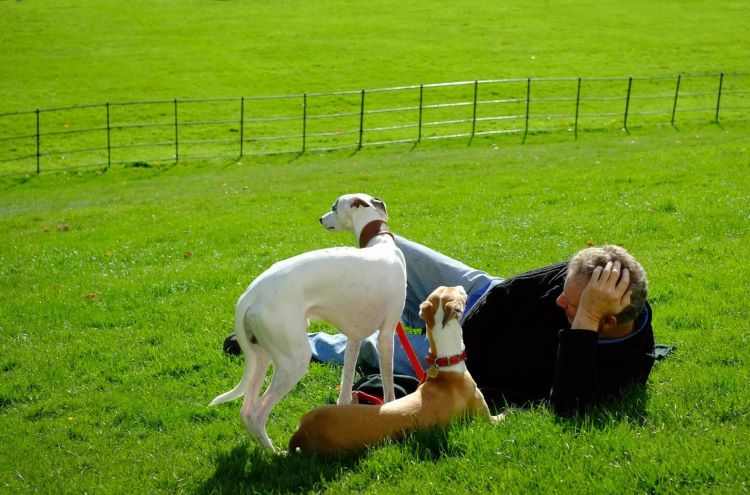Ready to help treat your pet to a healthy life?
Guide to the Greyhound: Breed History, Fun Facts & Health
By : Trupanion Staff | Published Jan 28, 2025

With long legs and a slender build, the Greyhound is arguably one of the most visually recognizable dog breeds. Most people know these sleek canines for their history as racing dogs, but they’re so much more than that. For example, these athletes also happen to make excellent family pets, with laid-back, gentle temperaments. If you’re debating adopting one of these fascinating canines yourself or are simply curious about the breed, we’ve got you covered with this Greyhound breed guide!
Ready to learn all about these sighthounds? We’ll kick things off with a little Greyhound trivia.
9 unique facts about Greyhounds
- They’re easily the fastest dog breed in the world, with the ability to reach speeds up to 45 miles per hour. However, these runners are best at sprinting, not distance or “endurance” running.
- Although Greyhounds are best known for being race dogs, this era may be coming to an end. Greyhound racing is now illegal in most parts of North America.
- They run with what’s called a “double suspension gallop,” which is the same running form as cheetahs in the wild.
- All that athleticism makes them sleepy! Greyhounds love snooze time, clocking between 16 and 18 hours a day. This far exceeds the average dog’s 10 to 12 hours of daily sleep.
- As sighthounds, Greyhounds rely far more on their eyesight — not smell — to explore the world around them.
- Though many think of them as gray, these dogs come in a wide variety of colors, including multi-color varieties.
- The name “Greyhound” likely doesn’t refer to color at all! It’s believed to come from “grighund” in Old English. While “hund” means “hound,” nobody knows what “grig” referred to.
- They make great family pets and adapt well to households with children.
- Despite their running abilities, Greyhounds love lounging and are considered low-energy, low-maintenance dogs.
Find out more fun things you didn’t know about Greyhounds.
What defines a ‘Greyhound’?
As mentioned, this breed has a sleek and athletic build, enabling it to run at high speeds compared to other dogs. Observers will notice the Greyhound’s long, narrow snout and head, accompanied by a tapered body with a large chest and comparatively slim waist. The tail is long and skinny, helping with balance and movement.

Kennel club breed standards for Greyhounds can vary slightly around the world. However, the general standards are as follows:
- Height: 27-30 inches (68.5-76.2 cm)
- Weight: 60-70 lbs. (27-31.8 kg)
- Skull: Dolichocephalic (a long, tapered skull with an elongated muzzle)
- Coat type: Short, dense, easy to maintain
- Coloring: Black, white, blue, red, fallow, fawn brindle, or any combination of these colors mixed with white.
Similar dog breeds
- Whippet
- Saluki
- Borzoi
- Afghan Hound
- Italian Greyhound
- Irish Wolfhound
- Scottish Deerhound
- Sloughi or “Arabian Greyhound”
Breed history
The Greyhound is often cited as one of the oldest dog breeds. But although a common anecdote has it that the dogs emerged in Ancient Egypt, the breed’s exact origins are unknown. Some of the earliest evidence for the Greyhound breed include images of similar-looking dogs found in a Neolithic site (circa 6000 BC) in present-day Turkey and a funeral vase dating back to 4200 BC in present-day Iran. Likewise, dogs with a strong resemblance to Salukis and Greyhounds have been found in Ancient Egyptian tombs.
Written history meanwhile shows that Greyhounds’ direct ancestors likely emerged sometime between those earlier ancient days and the establishment of the Roman Empire. The Romans then brought the dogs with them throughout Europe, where they went on to become favored by nobles in France and England in the Middle Ages. In fact, laws of the time stipulated only rulers and nobility could have Greyhounds; not anyone of the “lower” social classes. In these earlier days, they were used primarily as hunting dogs.
According to the book, The Greyhound and the Hare: A history of the Breed and the Sport by Charles Blanning, all modern pedigreed Greyhounds can trace their lineage to dogs registered in studbooks in the 18th and 19th Centuries.
Greyhound dog racing
Greyhound racing goes back to 16th Century England, but it wasn’t until the 18th Century that it really took off as a sport. The dogs’ roles shifted dramatically during this time from hunting dogs to racing dogs, spreading across Europe, North America, and other parts of the world over the following centuries.
Greyhound racing reached its peak popularity in the 20th Century, in the years following World War II. However, changing attitudes about the treatment of dogs combined with growing awareness of the difficulties faced by many racing Greyhounds resulted in increasing restrictions and bans by the new millennium. As of 2025, Greyhound racing remains legal in only a small handful of US states, though West Virginia is the only state with active tracks. It remains legal in Canada, though betting on the races is prohibited.
The United Kingdom currently allows and regulates Greyhound racing. Most other nations where the sport was popular have either banned it or have started phasing it out as of the 2020s.
Temperament and behavior
As noted earlier, Greyhounds are known for their gentle and calm temperament. Despite their history as racing and hunting dogs, they are surprisingly laid-back and enjoy lounging around the house. Many Greyhound owners describe them as "couch potatoes" who are always seeking out a comfy area to snooze for hours on end.
As for behavior, Greyhounds tend to be highly affectionate and form strong bonds with their human family members. They are generally good with children and other pets, including cats with proper introductions. However, they may have a strong prey drive due to their hunting instincts, so supervision and early socialization are musts.

Exercise needs
Even couch potatoes — okay, especially couch potatoes — need their daily exercise! As natural sprinters, Greyhounds are considered to have moderate exercise needs. This means shorter bursts of high-energy playtime here and there, rather than back-to-back hours of exercise. Many of these dogs will still enjoy lengthy outdoor adventures provided you go at a steady pace and bring enough water (and treats!), but for most, a few daily walks, some indoor playtime, and the occasional trip to the dog park is plenty.
Greyhound training tips
Intelligent and eager to please, these pups are easy to train with the right encouragement. Here are some tips:
- Use positive reinforcement — Reward-based training with treats, praise, and gentle encouragement works best. Greyhounds respond poorly to harsh discipline.
- Start with basics — Focus on simple commands like "sit," "stay," and "come." Keep training sessions short, around 5-10 minutes, as they can get bored easily.
- Leash train! — As a breed with a strong prey drive, leash training is crucial. Practice in a secure area to manage pulling or sudden chasing.
- Socialize early — As soon as your veterinarian approves, expose your pet to new people, pets, and environments early to reduce shyness and build confidence.
- Get a dog crate — Greyhounds often appreciate having a cozy, safe space to retreat.
- Provide mental stimulation — Use puzzle toys or interactive games to engage their intelligence.
- Be patient — All good things take time. Especially if you have a retired racing Greyhound, they may need extra time to adapt to new routines.
Breed health and care tips
Like all dogs, Greyhounds require regular exercise, monthly parasite prevention, and routine veterinary care. If you adopt one of these dogs, you’ll want to work with their veterinarian to make sure you’re feeding them a proper diet and are providing them with the best daily care possible. It’s also a good idea to be aware of the health risks these dogs may be predisposed to.
Common health conditions in Greyhounds
Greyhounds are a healthy breed overall, but their genetics and natural builds can make them more susceptible to certain health issues. Common conditions in Greyhounds include (but may not be limited to) the following:
- Bloat (Gastric Dilatation-Volvulus) — A life-threatening condition where the stomach rapidly expands and then twists, requiring immediate veterinary attention.
- Osteosarcoma (bone cancer) — Greyhounds are predisposed to this aggressive cancer, often affecting their limbs.
- Heart conditions — Such as dilated cardiomyopathy or heart murmurs, which may require monitoring or treatment.
- Arthritis — Particularly in retired racers due to their history of intense physical activity.
- Hypothyroidism — A condition where the thyroid gland underproduces hormones, causing lethargy and weight gain.
- Dental issues — Greyhounds are prone to tartar buildup, requiring regular dental care.
- Sensitive skin — While a light frame and thin skin/coat helps their running ability, it also makes them more fragile and prone to cuts or injuries.
- Anesthesia sensitivity — Due to their low body fat, Greyhounds require specialized care during surgeries.
Regular veterinary checkups, proper nutrition, and preventative care can all help manage or even prevent these issues. It’s also worthwhile to look into dog insurance to help with surprise care costs.

Famous Greyhounds
The most well-known Greyhounds tend to be racing dogs. That said, they’ve made some notable appearances in media over the years as well.
6 Greyhound athletes
If you’re wondering about the fastest Greyhound ever recorded, you’re going to see different answers across a variety of sources. However, general consensus suggests that these are some of the most impressive Greyhounds ever:
1. Ballyregan Bob
A British racing dog (1983 – 1994), Ballyregan Bob broke the world record for consecutive race wins.
2. Shakey Jakey
An Australian racing dog, this canine athlete won his first-ever race with an impressive 22-length lead in 2014.
3. Mick the Miller
Celebrated as England’s first great racing dog during his career in the late 1920s and early 1930s, Mick won the very first English Derby. He also became the first dog to complete a 525-course in under 30 seconds.
4. Master McGrath
An Irish Greyhound in the 1800s, Master McGrath’s numerous successes as a racing dog resulted in him meeting Queen Victoria and other members of the British royal family.
5. Cinderella May
A Greyhound athlete of her own, “Soaring Cindy” did not gain fame from racing. Instead, she snagged the Guinness World Record for the highest jump by a dog in 2006 after clearing an impressive 5.5-foot (1.7 m) hurdle in a televised event.
6. Feather
Though "Soaring Cindy" is often still cited as the record-holder for highest canine jump, her record was beaten in 2017 by another Greyhound named Feather. At two years old, this impressive dog jumped a whopping 6.29 feet (1.9 m)!
Greyhounds in movies and TV
Greyhounds are not the most common pups in modern media, but when they do appear, they’re memorable! For enthusiasts of the breed, here are some worthy examples:
- The episode “A New Leash on Life” of The Golden Palace (1992-1993) features Rose stealing a Greyhound to save her from race dog life and later making an impassioned speech about the need for responsible breeding and adoption of the dogs.
- Mr. Darcy’s dogs in the 1995 adaptation of Pride & Prejudice
- Herring’s dogs in Charlie Wilson’s War (2007)
- Skeletor in the movie, 50/50 (2011)
- Jock, Dr. Robert Ford’s pet dog in the Westworld TV series (2016-2022)
- The 2022 movie, Mrs. Harris Goes to Paris has a whole scene revolving around greyhounds and racing.
- Team mascot Earl Greyhound in Ted Lasso (2021-2023)
- Animated family dog Santa’s Little Helper in The Simpsons (1989-present)
